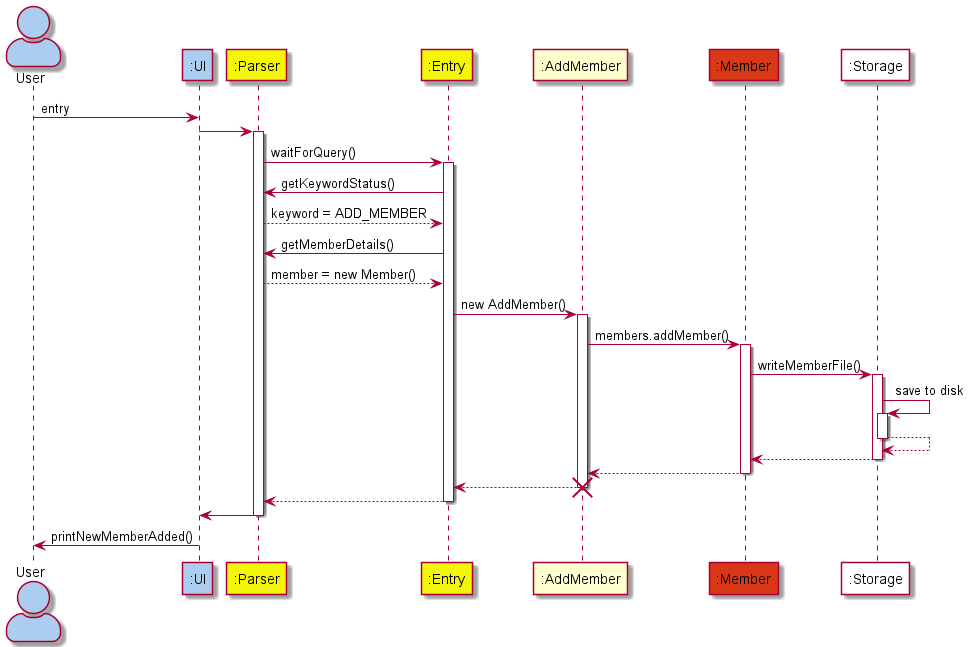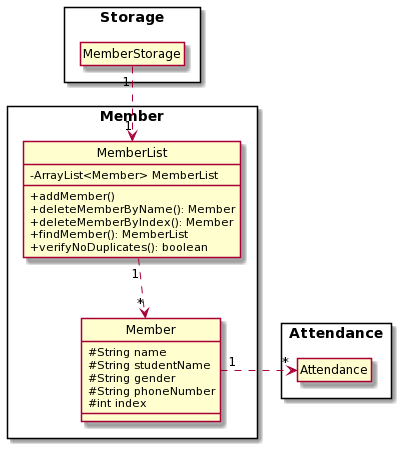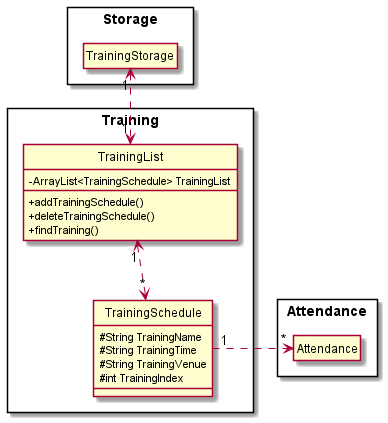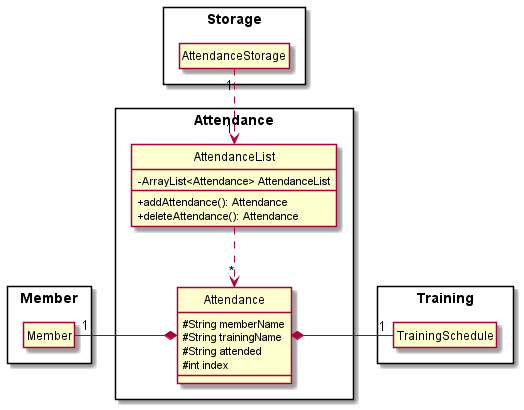Developer Guide
- Introduction
- Acknowledgements
- Setting Up
- Design
- Restrictions
- Appendix: Requirements
- Appendix: Manual Testing
- Exit
Introduction
CCA Manager is a simple and easy to use organisational planner for CCAs (Co-Curricular Activities) in NUS. It is designed specifically for students who are key appointment holders of such CCAs. Features include storing and tracking of information on CCA members, training schedules and attendance records which can be accessed quickly via a Command Line Interface (CLI). CCA Manager aims to centralise and optimize all CCA-related information, so that you can focus on improving other aspects of the CCA.
CCA Manager is written in Java 11 and designed with OOP (Object Oriented Programming) as a guideline to help design a modular and organized structure for the application.
Prerequisites: JDK 11, update Intellij to the most recent version.
Acknowledgements
- SE-EDU
- PlantUML
Setting Up
CCA Manager is written in Java 11, which you can download here.
You can retrieve the latest JAR version of CCA Manager here
You can retrieve the source code for CCA Manager here. You can refer here to learn how to fork and clone the repository of CCA Manager into your local workstation.
We recommend the use of IntelliJ when working on CCA Manager.
Design
Architecture

The architecture diagram above presents a high-level overview of CCA Manager.
Components of the architecture
UI: UI of CCA ManagerParser: Parses user inputs intokeywordsEntry: ConvertskeywordsfromParserintocommandsto runCommand: Executes a command based onkeywordgivenMembers: Stores member details asMemberobjects inMemberListTraining: Stores training details asTrainingScheduleobjects inTrainingListAttendance: Object that links aMemberto aTrainingScheduleStorage: Stores details ofMembers,TrainingandAttendancein hard disk space
Components Interaction
The sequence diagram below shows how various components of the architecture interact with one another when a user inputs a valid command "add /m Bob /s A01231234B /p 98765432"

Note:
- Examples below have their arguments removed for the sake of brevity
waitForQuery(): Blocks until a user input is received.getKeywordStatus(): Given user input, return thekeyword.getMemberDetails(): Given user input, return aMemberobject with all information from user input.addMember(): Calling a class that creates a newMemberobject and adds it to the MemberListmembers.members.addMember(): Adds a Membermemberto MemberListmembers.writeMemberFile(): Writes the content of MemberListmembersto the FilememberFiles, which should be a.csvfile in hard drive.
The sequence diagram below shows how various components of the architecture interact with one another when a user inputs a valid command "delete /m 1"
Note:
getKeywordStatus(): Gets the keyword value from the Keyword enum class.deleteMember(members, entry): Deletes the member from the memberList.deleteMemeber(memberNumber): Deletes the member using the index number provided by the user.writeMemberFile(): Writes the data to the csv file.
The sections below give more details of each component.
UI Component

Hint: You can click on the Application Programming Interface (API) links to be redirected to its source code!
API : Ui
The Ui component handles the output display of CCA Manager. Whenever the user enters a command, the Ui class will print a message corresponding to the user input.
Current Functionalities:
- Display message on start-up.
- Help message when user inputs
--help. - Listing of
MembersinMemberList. - Listing of
TraininginTrainingList. - Listing of
AttendanceinAttendanceList. - Displaying error messages on invalid command inputs.
- Displaying success messages on valid command inputs.
Parser Component

API : Parser
The Parser component handles the input parsing of CCA Manager. User input is parsed to produce a keyword and corresponding inputs, such as index , name, etc. are identified.
A keyword is an identifier used by CCA Manager to determine what operation (add, edit, delete or list) to do.
Current Functionalities:
- Retrieving
keywordfrom user input. - Create a
TrainingScheduleobject from user input. - Create a
Memberobject from user input. - Create a
Attendanceobject from user input.
Entry Component

API : Entry
The Entry component performs a command based on the keyword given. If the user enters an invalid command, for example, the Entry component will direct the Ui component
to print an error message. It uses simple switch-case statements to handle the different keyword received.
Command Component

API : Command
The Command component directly interacts with the Member, Training or Attendance component based on the keyword given in order to perform a specific operation.
Current Functionalities
- Adding
MembertoMemberListin Member Component. - Adding
TrainingScheduletoTrainingListin Training Component. - Adding
AttendancetoAttendanceListin Attendance Component. - Deleting
MemberfromMemberListin Member Component. - Deleting
TrainingSchedulefromTrainingListin Training Component. - Deleting
AttendancefromAttendanceListin Attendance Component. - Editing a field in
Member - Editing a field in
Training - Finding a specific
MemberinMemberListSearch by indexandSearch by member nameis supported.
- Finding a specific
TrainingScheduleinTrainingListSearch by indexandSearch by training nameis supported.
Member Component

API : Member
The Member component consist of MemberList and Member. Member consist of important member information such as name, studentName, gender, phoneNumber and index which is the index of member shown to user of the program.
Current Functionalities
- instantiates an
MemberListobject comprising 0Memberobjects. - stores inputted
Memberobjects in a list as anArrayList<Member>inMemberListclass. - stores the
MemberListobject in a csv file with the help ofMemberStorage.
Training Component

API : Training
The Training component consists of TrainingList and TrainingSchedule. Information regarding Trainings, such as name, date/time and venue are handled by the Training component.
Current Functionalities
The Training component,
- instantiates a
TrainingListobject of 0TrainingScheduleobjectsTrainingSchedulesin aTrainingListhold anIndexthat CCA Manager uses in relevant commands, such asdelete by indexorfind by index
TrainingScheduleis an object that holds the information of CCA information, such as:- Training Name
- Training Date
- Training Venue
- stores
TrainingScheduleinTrainingListwheneveraddTrainingSchedule()is called - edits
TrainingScheduleinTrainingListwheneverEditTraining()is called - removes
TrainingSchedulefromTrainingListwheneverdeleteTrainingSchedule()is called - returns a list of matching
TrainingSchedulewheneverfindTraining()is called - stores
TrainingListentries on disk inCCATrainings.csv
Attendance component

API : Attendance
The Attendance component,
- instantiates an
Attendanceobject comprising of 1Memberobject and 1TrainingScheduleobject. - stores inputted
Attendanceobjects in a list as anArrayList<Attendance>inAttendanceListclass. - stores the
AttendanceListobject in a csv file with the help ofAttendanceStorage.
Storage component
API : Storage
The Storage component consists of 3 sub-components, corresponding to MemberStorage , AttendanceStorage
and SrainingStorage
The MemberStorage component
- can save members’ data in CSV format and read them back into the
MemberListobject. - automatically adds to DukeMembers.csv whenever a new member is added to the
MemberListobject. - automatically edits to DukeMembers.csv whenever member details are edited in the
MemberListobject. - automatically deletes to DukeMembers.csv whenever a member is deleted from the
MemberListobject.
The AttendanceStorage component
- can save attendance data in CSV format and read them back into the
AttendanceListobject. - automatically deletes to AttendanceStorage.csv whenever a member is deleted from the
AttendanceListobject.
The TrainingStorage component
- can save trainings schedules and read them back into the
TrainingListobject. - automatically deletes in the file whenever a training schedule is deleted from the
TrainingListobject.
When the program is run, it will either create the relevant files if it is the first time running, or it will load the relevant files. While loading, if there is any invalid fields in any of the data files,it will terminate the program with a message prompt telling the user to make all inputs valid before running the program again.
Restrictions
IMPORTANT!
One restriction of the current implementation (v2.1) of CCAManager is that the user input cannot contain any commas.
This is because data is saved in a .csv file, which uses commas as field delimiters. Hence, if user input were to contain commas, this may cause data to be imported inaccurately during the loading of existing files at start-up.
Appendix: Requirements
Product scope
Target user profile
- Is in an administrative position for a CCA in NUS, and deals with the book-keeping of CCA information
- Has the need to centralize and record a multitude of CCA information (member details, training schedules, etc.)
- Is comfortable with the use of CLI such as
cmd.exe - Prefers typing to mouse interactions
- Prefers the use of desktop apps for CCA administrative matters over other alternatives (mobile app, etc.)
- Can type fast
Value proposition
User can update CCA information faster than using a GUI, and offers a centralized platform to store all relevant CCA information
User Stories
| Version | As a … | I want to … | So that I can … |
|---|---|---|---|
| v1.0 | CCA Leader | Add member details | Keep a record of all active members and know how to contact them |
| v1.0 | CCA Leader | Edit member details | Keep the details of active members updated and accurate |
| v1.0 | CCA Leader | Delete member details | Reduce clutter by removing entries for members no longer in the CCA (Graduated,Quit,etc.) |
| v1.0 | CCA Leader | Add training schedule | Record an upcoming training and its details for reference |
| v1.0 | CCA Leader | Edit training schedule | Update details of an upcoming training in case of any sudden changes (Venue,Date/Time,etc.) |
| v1.0 | CCA Leader | Delete training schedule | Remove any erroneous trainings (Cancelled training,etc.) |
| v1.0 | CCA Leader | Export data to .csv | Keep a backup of updated CCA information and make use of Excel formulas and macros to help with book-keeping |
| v1.0 | CCA Leader | Import data from .csv | Automatically read saved CCA information |
| v2.0 | CCA Leader | Add attendance | Keep track of which members attended which training sessions |
| v2.0 | CCA Leader | Delete attendance | Remove any erroneous attendance (Listed member as present when he was not,etc.) |
| v2.0 | CCA Leader | Find member | Find specific members if I need any of their details. |
| v2.0 | CCA Leader | Find training name | Filter out which Trainings I want to find out about. |
Non-Functional Requirements
- CCA Manager should work on any modern OS which has
Java 11installed - CCA Manager should be able to record a lot of data without noticeable performance issues
- A User with above average typing speed should be able to get tasks done faster with the use of CCA Manager compared to using a mouse
Appendix: Manual Testing
Setup
- Download the latest release from here
Initial Launch
- Place
CCAManager.jarin your folder of choice. - Run
cmd.exe - Run CCA Manager by calling
java -jar CCAManager.jaroncmd.exe- Note that
cmd.exemust be in the directory ofCCAManager.jar
- Note that
Running Commands
- You can refer to the list of commands here
- Upon a successful command run, data will be saved to
DukeMembers.csv
Testing Member-related features
- Storing a new member, with a unique student ID
- Input:
add /m /n John Hwee /s A1231234B /g M /p 98765432 - Expected Output: Assuming that the program is run for the first time,
John Hweewill be the first entry inMemberListand given an index of1 - A new .csv file named
CCAMembers.csvwill be created andJohn Hweewill be recorded in it
- Input:
- Storing a new member, with an existing student ID
- Input:
add /m /n Frank Han /s A1231234B /g M /p 91231234 - Expected Output: Since
John Hweealready has the student numberA1231234B, this command will not succeed. An error message will be printed.
- Input:
- Editing a member’s information
- Input:
edit /m 1 /p 91234567 - Expected Output:
John Hweewas assigned the index1above, so this command will update his phone number to91234567 - The change will be recorded in
CCAMembers.csvas well
- Input:
- Listing out all members
- Input:
list /m - Expected Output: Since
Frank Hanwas not successfully added, onlyJohn Hweeexists in the member list. Hence, this command will show only 1 member:John Hwee
- Input:
- Delete member
- By name
- Input:
delete /m John - Expected Output: Since there is only one member in the list, whose name is
John Hwee, his entry will be deleted
- Input:
- By index
- Input:
delete /m 1 - Expected Output: Since
John Hweeis assigned index1, his details will be deleted from the list.
- Input:
- The entry will be deleted from
CCAMembers.csvas well
- By name
Testing Training-related features
- Storing a new training, with a unique training name
- Input:
add /t /n Friday Training 1 /a 5 Nov 2021 /v MPSH1 - Expected Output: Assuming that the program is run for the first time,
Friday Training 1will be the first entry inTrainingListand given an index of1 - A new .csv file named
CCATrainings.csvwill be created andFriday Training 1will be recorded in it
- Input:
- Editing an existing training detail
- Input:
edit /t 1 /v MPSH2 - Expected Output: Since
Friday Training 1is assigned the index1, its venue will be updated fromMPSH1toMPSH2 - This change will be reflected in
CCATrainings.csv
- Input:
- Listing out all trainings
- Input:
list /t - Expected Output: Since there is only 1 training entry,
Friday Training 1, the list command will succeed and show the details ofFriday Training 1
- Input:
- Delete an existing training
- By name
- Input:
delete /t Friday - Expected Output: Since there is only one training entry in the list,
Friday Training 1, it will be deleted since it matches the searchFriday - If there are more than 1 entries in the training list that contains
Friday, you will be given an additional prompt to key in the index matching the training you wish to delete
- Input:
- By index
- Input:
delete /t 1 - Expected Output: Since
Friday Training 1is index1, it will be deleted
- Input:
Friday Training 1will be removed fromCCATrainings.csvas well
- By name
Testing Attendance-related features
- Adding a new attendance
- Input:
add /att /m John Hwee /n Friday Training 1 /d 1 - Expected Output: If there is a
John Hweein the Member list AND there is aFriday Training 1in the Training List, this command will succeed - Attendance entries are reliant on the members and trainings already existing beforehand
- If this command succeeds,
John Hweewill be added as an entry toFriday Training 1.csv, located in theAttendancesub-folder.- If
Friday Training 1.csvdid not exist before, it will be created
- If
- 1 represents ‘Present’, 0 represents ‘Absent’
- Input:
- Deleting a valid attendance
- Input:
delete /att /t Friday Training 1 /i 1 - Expected Output: This will delete the first member in the
Friday Training 1attendance list. In the above case, if the command succeeded thenJohn Hweewould be index1. Hence, his entry would be deleted
- Input:
- Listing all attendance entries
- Input:
list /att /t Friday Training 1 /d 1 - Expected Output: This will list ALL the members who were present for
Friday Training 1. In this case, onlyJohn Hweewould be listed. - Regardless of whether your syntax is correct or not, there will be a prompt to ask whether you would like to list the FULL attendance list
- Reply with
yto see the full attendance list, andnto skip
- Reply with
- Input:
Exit
- Call
byeto exit CCA Manager.
